SAILING IN THAILAND
Most of our sailing in Thailand has been trips between Langkawi, Malaysia and Phuket, Thailand, but we also took a wonderful five-week cruise along Thailand’s west coast. We will describe these two distinct areas separately below.
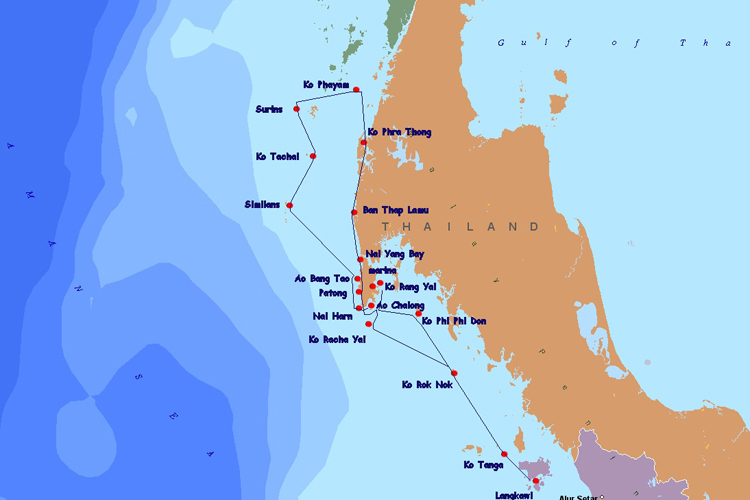
Ko Tarutao was an unplanned stop on one of our trips north. We were less than an hour out of Langkawi when the wind started increasing, and we could see squalls coming our direction. We ducked in to an anchorage on the west coast, and we found fair protection from the deteriorating weather. It was a little breezy and bumpy during the night, but we were experiencing far less weather than the few boats still sailing nearby whose radio communications we could hear. We spent the night and left in the morning, so we have no other knowledge of the island.
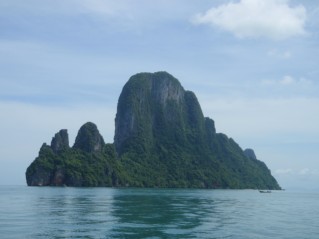
Ko Phetra
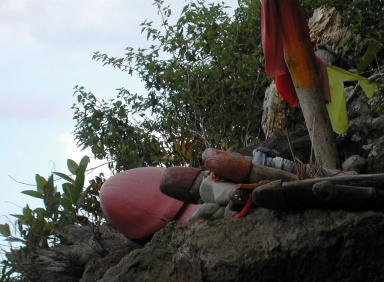
Penis Shrine
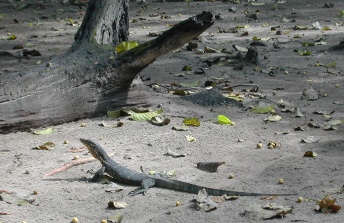
Monitor Lizards Everywhere
We also went ashore on Ko Rok Noi. The first thing one notices is the tsunami warning system – sirens, signs. Rok Noi was badly hit by the tsunami on December 26, 2004. Then you notice the lizards. There are monitor lizards everywhere! They range from one to three feet in size, and they appear accustomed to humans being nearby. One also notices that the ground appears to be alive. Countless thousands of shells containing hermit crabs are moving around.
Numerous fast boats arrive from Phuket throughout the day with sunburned snorkelers on board. We watched where they went, then we went there after they left. The coral was nice, and the fish were plentiful. The fish are obviously accustomed to being hand fed – they swarm around your hands.
However, almost all of our numerous stops at Ko Rok Nok have been uncomfortably rolly. We have since been taking a more easterly route and passing by Rok Nok.
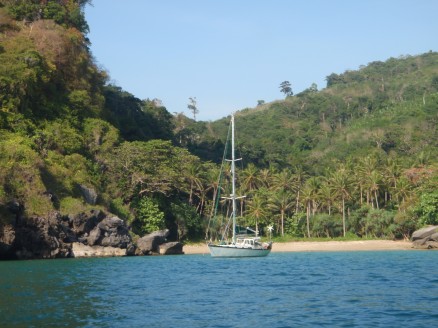
Beautiful Bay on Ko Muk
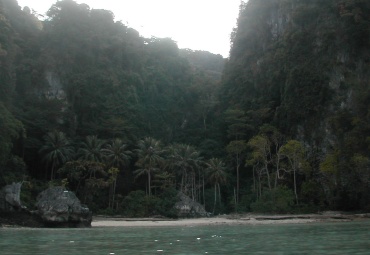
Ton Sai Bay on Phi Phi Don the view from our stern
Phi Phi Don is beautiful. The terrain is spectacular. However, it is also very busy. Power boats travel in and out of Tonsai Bay almost constantly and at high rates of speed. Their wakes make the anchorage barely tolerable. We have also had a few squalls blow over us at Phi Phi Don with big winds. It is not a particularly restful place.
We have also anchored off the east shore, and it was much quieter even though there is a lot of longtail traffic. But when the boats have all gone home for the night, it is very peaceful.
And we foolishly anchored in a bay on the north of the island – but only once. The music coming from the bars on shore was loud and it seemed to go on all night.
Phi Phi Don is very much a tourist island, and it is a good stop if one wants to shop of go to restaurants and bars. But it lacks in restfulness when one is seeking a quiet anchorage and a good night’s sleep.
Ko Racha Yai is 13 miles south of Ao Chalong. We knew it was a popular destination for day boats out of Phuket, but we had no idea how popular it was! There were a few cruising boats anchored there when we arrived, and at least ten dive boats came in each day. We stayed on board during the days to avoid the crowds.
There are two small resorts at the head of the bay where we were anchored. One was a bit of an eyesore, but one was quite lovely. We went ashore one evening to see them, and they were very unwelcoming including ‘no trespassing’ and ‘hotel guests only’ signs. No, we didn’t spend any of our money there.
Bud had caught a bit of a cold, and he was feeling puny, so we stayed at Ko Racha Yai longer than we would have liked. But we left as soon as he was feeling a bit better, and we have not returned.
Ko Rang Yai is a small island just across a small bay near the entrance to Boat Lagoon and Royal Phuket Marinas. The channel to these marinas is quite shallow, and it is tide dependent. Keel boats must enter and exit only on high tides, and many boats anchor at Ko Rang Yai to wait for a favorable tide.
We have anchored on both the east and west side of the island in different wind conditions, and both were pleasant anchorages. Although there is a pearl farm and a few tourist attractions, we have never been ashore. However, whenever we are traveling up or down Phang Nga Bay, we usually stop and spend a night at this quiet and peaceful island.
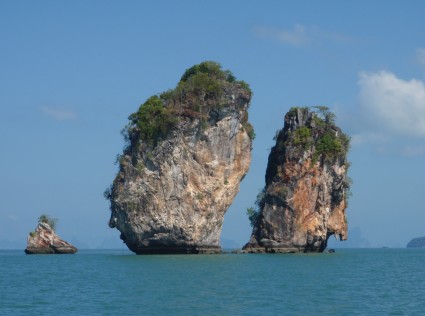
Just outside Ko Yao Yai
We traveled 20 miles down around the southern tip of Phuket to the first bay on the southwest coast – Nai Harn. We had heard that Nai Harn was a popular anchorage, but we didn’t expect it to be as big and busy as it was. We counted 58 boats, and there were likely more that we did not count.
There was lots of activity here. We saw a few boats leaving westward to begin their Indian Ocean crossing, and we saw a lot more boats going ashore. There are a few resorts ashore, but we don’t know anything about them or what they offer.
We anchored in the northwest corner of bay – on the outside – and stayed on board. We left the following morning without doing any exploring.
We sailed only 17 miles north to Ao Bang Tao. We found this an interesting anchorage in what we did not see here. Apparently there are eight or nine large resorts just off the beach. They are all linked by a roadway and a waterway. But we neither saw nor heard anything during our brief stay there. We spent one quiet night there and moved on.
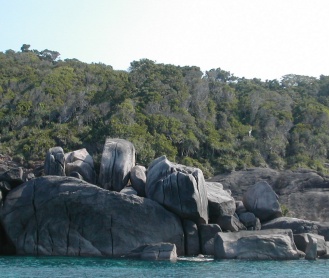
Dramatic rocky shoreline in Similan Islands
There are ranger stations on islands #5 and #8, and boats are expected to check in at either of the stations. As we sailed toward the islands, we saw numerous (15 to 20?) boats leaving #5 and heading back toward Phuket, so we assumed (wrongly) that it was the busiest island. We opted to check in at #8.
When we arrived at #8 in the mid-afternoon, it was nuts. Similan Bay is small and shallow with about ten moorings crowded in it. More than 10 boats were circling around, and a few fast boats came racing in increasing the havoc. One of the rangers directed us to a particular mooring which we picked up. Once we were secure, we sat back and questioned what we were doing there. We decided to check in with the rangers in the morning then head off to a quieter anchorage.
The following morning we went ashore to the ranger station, and it was sheer madness. There were fast boats racing in and out of the small bay, and there were at least 100 tourists ashore for lunch. We paid our park fees, and we were fortunate to meet a dive guide whom spoke English, so we talked with her about where to go to escape the maddening crowds. We went back to Passage and left Similan Bay immediately.
We headed around #8 in a counterclockwise direction, and we finally picked up a mooring on the east coast. There were a few dive boats along the coast, but there was adequate breathing room. We wanted to dive, but there was too much current to dive without a chase boat. So we snorkeled while towing the dinghy. The snorkeling was nice, but nothing special.
After only one night, we headed further north. We circled #9 – Ko Banga – in a counterclockwise direction. We had hoped to anchor on its north side, but it was much too rough. We ended up on a mooring on its south side – too close to the insane Similan Bay. And although we got too much traffic there, the diving was nice right under the boat, so we stayed for three nights. We did a few fair day dives and one rather dull night dive. It was, nonetheless, nice to dive off Passage without having to load gear in to and out of the dinghy. But we were looking for better, so we headed further north.
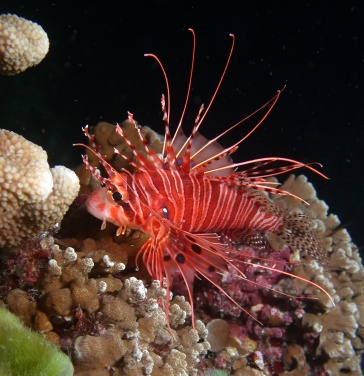
Night Diving off Ko Banga
Ko Tachai is 27 miles north of the Similans. It is a very pretty island with a small ranger station ashore. It is too far from Phuket for day boats to travel, and only liveaboards, fishing boats, and cruisers go there.
There is an anchorage off the southeast corner that is used by liveaboard dive boats. We were seeking a bit more isolation, so we went around to the shallow anchorage on the north side. It is a spectacularly beautiful anchorage, but it is a minefield of bommies. We carefully picked our way in and tied up to a mooring. Blessed quiet.
Shortly after sundown, we started to roll. We continued to roll throughout the night. We couldn’t leave at night because of the bommies, so we grumbled and endured. It was a miserable night, and we left in the morning.
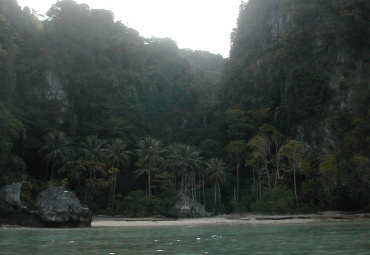
Picture Postcard Scenery in Surin Islands
We made a quick 22 mile trip north to the Surin Islands. It was love at first sight.
The Surin Islands are also a national park. There are two primary islands and a few smaller islands surrounding them. There is a shallow non-navigable channel between the two primary islands. They are uninhabited except for a small group of sea gypsies on the southern island.
There are numerous stout moorings to tie to, and they are used mostly by fishing boats. Most of the moorings are also within 100 feet of a worthy dive site. The diving was shallow with very rich fish life; however, the visibility was not as good as we expected. It was, nevertheless, very nice diving, and we did a lot of diving there.
We went ashore looking for the ranger station to pay our park fees, and we were surprised to find a campground and camp restaurant. It cannot be seen nor heard from the anchorage. We ate at the restaurant and enjoyed it. And we learned that the ranger station is at a second campground on the other side of the bay. We went there, and it, too, was thoroughly removed from the anchorage. This was great!
We were visited by two sea gypsy boats, and we enjoyed our limited interactions with them. We gave them a few things – batteries, a t-shirt, gasoline, coffee – and they offered us what little they had – dried squid. We declined the squid, but we appreciated that they were trying to trade rather than beg.
We explored the islands by dinghy, and we roamed about onshore a bit. And we did some more diving.
We would have stayed longer in the Surins, but Bud’s visa was nearing expiration. We had decided that we would go to Rangon , Thailand – just below the border with Myanmar (Burma) – and Bud would make a ‘visa run’ (a ridiculous industry in Thailand and surrounding countries) across to Myanmar which would give him another 30 day visa in Thailand. So we left the Surins while still wanting more.
On our way to Rangon, we sailed 40 miles east and stopped at Ko Phayam – just over halfway between the Surins and Rangon. Sailing the rhumbline between the Surins and Ko Phayam will take you a few miles in to Myanmar’s waters, and they reportedly don’t appreciate uninvited guests, so we made a slight arc to the south. We probably did sail slightly in to their waters; but if so, it was slight.
When we went ashore, we decided that we wanted to stay on Phayam rather than go to Rangon. So Bud arranged to get a fastboat from Phayam to Rangon, and we would keep Passage at Phayam for a few days.
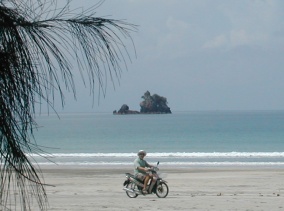
Bud did make his visa run, and we both had visas until the end of February – another month in Thailand. Meanwhile, we got out and enjoyed Phayam.
Phayam has a rather shallow sand anchorage with good holding, and we found an easy dinghy landing at the northern end of the beach. Ashore there are no cars or trucks – only motor scooters. The few roads are concrete paths about six feet wide, and lots of travel is done riding along the beach. We rented a scooter for the equivalent $6 USD per day (they can be had for $4.50 if you bargain) and headed off to explore.
We called our scooter ‘Lucy’ because everything on her was loose. She shook and rattled and did not idle. We worried about her making it up a few small hills, but she lasted the day and took us on a great tour.
The first thing one notices about the island is that it seems a time warp back to the 1960s. Bob Marley rules, dreadlocks are the rage, and we were possibly the only people on the island that had no clothing with marijuana leaves on them (thank goodness we at least have some tie-dye!).
The main village on the island was small and not particularly interesting but still worth visiting. There are two roads that led east-west across the island, and there is a small village near the western end of the northern road. We particularly enjoyed that village. Those roads also gave us a glimpse of life on the island, and it is charming even if a bit rustic for old folks like us. And riding along the hard-packed sand on the beach was great fun.
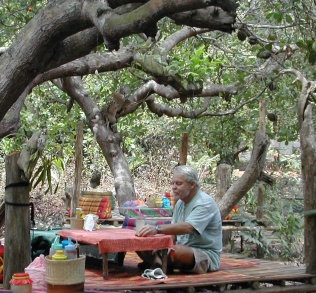
Our favorite restaurant on Ko Phayam
Baan Nau Chaa
There are various backpacker resorts and bars scattered about the beaches, and there are ample eateries. We found one restaurant that we loved – Baan Nau Chaa. It is run by a lovely French woman whom has been living in Thailand for almost a decade, and she is a great vegetarian cook. She is also an accomplished baker, and we left some sourdough starter with her in hopes that she might add some sourdough to her repertoire.
We had a Burmese dinner there one night, and it began to rain – not drizzle or sprinkle, but downpour. We waited about half an hour for it to ease, and there was no let-up in sight. So we made the 40 minute walk back to the dinghy in pouring rain. We were soaked through, and the dinghy was rapidly filling with water. Quite the gullywasher.
We also hiked about a bit and enjoyed the scenery. And the locals were particularly friendly and helpful. Phayam was a particularly good experience for us.
However, even though Bud had another 30 day visa, it was time to head south so that we would have time to stop along the way. If we make it up this far north again, we will definitely return to Phayam!
Ko Phra Thong was just an overnight stopover for us 35 miles south of Ko Phayam. The anchorage here is a large channel inside a few islands, and it feels like a river. There are a few small villages on shore, but we did not go ashore.
We anchored about five miles inside, and we were in the middle of the channel. However, the mosquitoes still somehow found us. How do they do that?!
We had a quiet night other than a few pesky mosquitoes, and we left in the morning. We motored another 17 miles inside the channels before returning to the Andaman Sea. It was quite different and interesting.
We sailed another 43 miles south to Ban Thap Lamu. This is a medium-sized harbor that is home to a navy base. There were also many types of boats anchored throughout the harbor – longtails, fishing boats, dive boats, cruising boats, etc. Thai fishing boats are quite charming in design, and this harbor was home to a particularly eye-catching fleet.
We went ashore to see what was there, and we found a lot. There is a busy wharf area that services the commercial fishing boats and dive boats. Many divers come here to catch boats out to the Similan Islands. There is also a building and repair facility for longtails. And there is a cottage industry building fish traps that seems to involve much of the village. We walked off the beaten path a bit, and enjoyed seeing a bit of local life (although it appeared that much of the local life was surprised to see us). We ate at the Navy Wives’ Club, and it was very good.
We returned to Passage just before dark and got a good night’s sleep. We were off again the next morning.
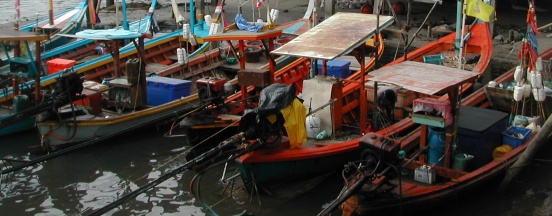
Colorful Longtails in Ban Thap Lamu
We sailed 34 miles south to Nai Yang Bay and arrived early afternoon. Nai Yang is the northernmost anchorage on Phuket. It is just south of the airport which is at the northern tip of the island. It is definitely a ‘tourist town’, but it also has lots of charm.
The first things we noticed about Nai Yang were the jellyfish. They were huge – probably three feet across. And they were beautiful colors – bright pink and lavender. In any direction you looked, you would see at least ten of them on the surface. We don’t how much sting these jellies have, but just their size and numbers convinced us that we did not want to be in the water with them. (Interestingly, two of the most painful and dangerous jellyfish are the Portuguese Man-of-War and the box jellyfish which are both very small). We had hours of daylight remaining, so we went ashore to explore.
The beach is nearly covered with bars and eateries. We had a nice lunch on the beach at one of the eateries. We roamed up and down the main beachfront street and looked at the usual tourist shops selling mainly t-shirts, hats, and sunglasses. And although it was ‘just another tourist town’ in many ways, we particularly liked this town. Maybe we were clinging to our last bit of ‘laid back’ before facing the sensory overload of Patong. And after only one night, we left and headed for Patong.
We had a quick fourteen mile sail to Ao Patong, and, as expected, the anchorage was a bit crazy when we arrived. There were lots of the usual boats, but the craziness seemed to stem from the incessant boat traffic and jet skis. We had not traveled to Patong by land while staying in Royal Phuket Marina, and this was our first experience there.
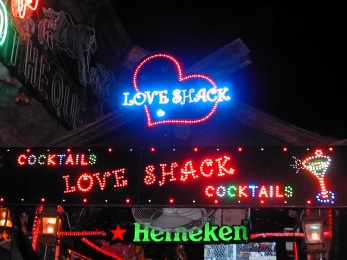
Night Life in Patong
Patong is the largest tourist town on Phuket. The vast majority of tourists that flock to Phuket head for Patong. There are countless bars, restaurants, and hotels to suit every budget. The streets are packed with the usual tourist shops, and there is a bit more shopping if you get back a few blocks off the beach.
The beaches themselves are covered with sun worshipers and massage huts. There are also parasailing boats and obnoxious jet skis. It is a typical beach resort scene.
We took the bus across the island to Phuket Town (20 THB, the equivalent of about 60 cents US). We did some provisioning, and Nita was uncontrollably drawn back to the fabric stores. We had shopped at Carrefour supermarket in Bali, and we found many things we wanted and/or needed. However, we shopped at the large Carrefour in Patong, and we were disappointed in what we did not find. So we made another trip across the island back to Phuket Town. We really enjoy Phuket Town.
Patong is not only Phuket’s main tourist town; it is also its ‘Sin City’. In Patong, gender is not a dichotomy but rather a continuum. There are working girls, boys, and various combinations thereof. And most of this action is based on Banga Road.
We took a walk down Banga Road one afternoon, and we were surprised how tame it seemed. So we decided to go back after dark to see if its character changed. It did! The bars were busy, the neon lights were flashing, and the working girls/boys/combos were out in force. The most beautiful women we saw were, in fact, not women at all. There is a large ‘lady-boy’ population in Patong, and some of them are head-turning beautiful. It was a very colorful evening.
But the jet skis were starting to annoy us, and we were ready to head further south. So we left Ao Patong on February 12 looking to reclaim a bit of our ordinary sanity. It is so easily lost in Patong.
We planned to return to Ao Chalong to check out of Thailand and head back to Malaysia. The winds were light, so we were motorsailing. Just outside Nai Harn Bay, we picked up a fibrous polypropylene bag in our prop. It was really a mess. We were able to tack and sail in to Nai Harn Bay where we dropped an anchor. Bud removed the fibrous remains of the bag with a pair of scissors, and we decided that we would enjoy the afternoon in the bay. This seemed a good respite between the craziness of Patong and the business of Ao Chalong. We did nothing and thoroughly enjoyed the day. Tomorrow – Ao Chalong.
It was only seven miles around the corner, and we were back where we started – in Ao Chalong. This is where we checked in to Thailand, and it is where we would check out with some disappointment. We were not disappointed in Thailand (we love Thailand!) but disappointed that we had to leave for a while.
We also wanted to take care of a few chores before returning to Malaysia. Our compressor hose had developed a small leak at one end fitting, and there is actually a small compressor shop in Ao Chalong to service the many dive boats. They were able to replace the fitting. While Bud was dealing with the compressor hose, Nita walked next door to the custom wetsuit shop, and she was being measured up within the hour. She had two fittings and a completed suit by 5:00 pm the following day. We ate at Jimmy’s Lighthouse – somewhat of an institution in Ao Chalong (their Masuman curry is fabulous!).
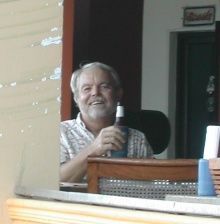
A beer at Jimmy’s before we go
We had exhausted Bud’s current visa, so we checked out and went back to Malaysia. But we knew that we wanted to spend more time in Thailand, and we would return soon.
Return to our sailing in Malaysia or go forward to our sailing to/from India’s Andaman Islands
Or, go back to our destination page for Langkawi, read about our time on land in Thailand, or go forward to the Andaman Islands